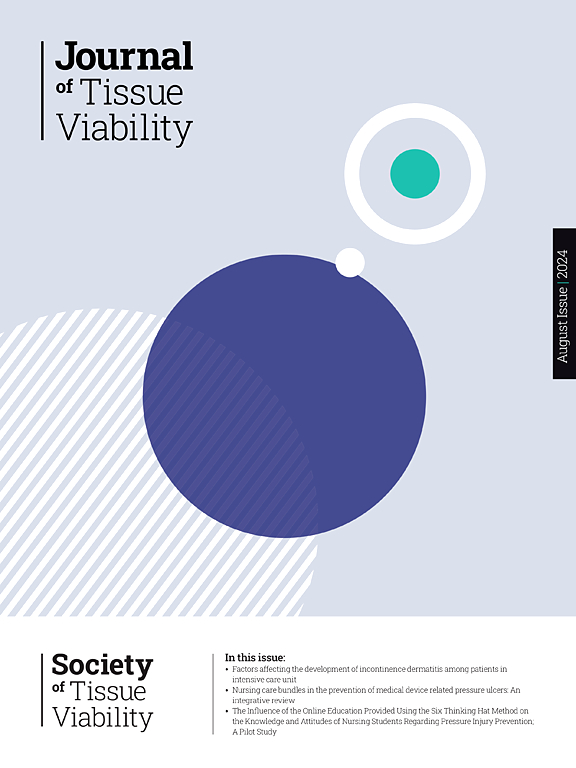Prevalence and incidence of skin tear in older adults:A systematic review and meta-analysis
IF 2.4
3区 医学
Q2 DERMATOLOGY
引用次数: 0
Abstract
Background
Skin tear (ST) is a public health problem in older adults; they substantially increase the risk of complications and cause serious adverse consequences and health care burden.
Aim
To estimate the pooled prevalence and incidence of ST among older adults.
Methods
Ten databases were systematically searched from their inception to July 27, 2023. Two researchers performed a systematic review independently according to the Preferred Reporting Items for Systematic Reviews and Meta-Analyses guidelines. All inconsistencies were resolved by a principal researcher. The pooled prevalence and incidence of ST were estimated in R 4.3.1 program.
Results
Thirteen studies were included in this review. The pooled prevalence of ST was 6.0 % (95 % confidence interval (CI): 3.0%–11.0 %, I2 = 98 %), and the pooled incidence was 11.0 % (95 % CI: 5.0%–19.0 %, I2 = 94 %). The prevalence of ST was 11.0 % (95 % CI: 5.0%–19.0 %, I2 = 95 %) in long-term care facilities, 5.0 % (95 % CI: 3.0%–9.0 %, I2 = 86 %) in Europe, and 7.0 % (95 % CI: 1.0%–16.0 %, I2 = 82 %) in the Skin Tear Audit Research classification system (STAR). It has stabilized at 6.0 % since 2021. The incidence of ST was 15.0 % (95 % CI: 11.0%–20.0 %, I2 = 66 %) in long-term care facilities in Japan and 4.0 % (95 % CI: 2.0%–6.0 %) in Canada.
Conclusions
Older adults are at a high risk for ST. Our findings emphasize the importance of epidemiologic studies and further exploring assessment tools for ST. Healthcare professionals should pay attention to ST, identify high-risk individuals and associated factors, and implement targeted prevention strategies for older adults.
老年人皮肤撕裂的流行率和发病率:系统回顾和荟萃分析。
背景:皮肤撕裂(ST)是老年人的一个公共卫生问题;它大大增加了并发症的风险,并造成严重的不良后果和医疗负担:方法:系统检索了从开始到 2023 年 7 月 27 日的 10 个数据库。两名研究人员根据《系统综述和元分析首选报告项目》指南独立进行了系统综述。所有不一致之处均由一名主要研究人员解决。用 R 4.3.1 程序估算了 ST 的总体流行率和发病率:本综述共纳入 13 项研究。汇总的 ST 患病率为 6.0%(95% 置信区间 (CI):3.0%-11.0%,I2 = 98%),汇总的发病率为 11.0%(95% 置信区间 (CI):5.0%-19.0%,I2 = 94%)。在长期护理机构中,ST 的发病率为 11.0 %(95 % CI:5.0%-19.0 %,I2 = 95 %),在欧洲为 5.0 %(95 % CI:3.0%-9.0 %,I2 = 86 %),在皮肤撕裂审计研究分类系统(STAR)中为 7.0 %(95 % CI:1.0%-16.0 %,I2 = 82 %)。自 2021 年以来,发病率稳定在 6.0%。日本长期护理机构的 ST 发生率为 15.0 %(95 % CI:11.0%-20.0 %,I2 = 66 %),加拿大为 4.0 %(95 % CI:2.0%-6.0 %):老年人是 ST 的高危人群。我们的研究结果强调了流行病学研究和进一步探索 ST 评估工具的重要性。医疗保健专业人员应关注ST,识别高危人群和相关因素,并为老年人实施有针对性的预防策略。
本文章由计算机程序翻译,如有差异,请以英文原文为准。
求助全文
约1分钟内获得全文
求助全文
来源期刊

Journal of tissue viability
DERMATOLOGY-NURSING
CiteScore
3.80
自引率
16.00%
发文量
110
审稿时长
>12 weeks
期刊介绍:
The Journal of Tissue Viability is the official publication of the Tissue Viability Society and is a quarterly journal concerned with all aspects of the occurrence and treatment of wounds, ulcers and pressure sores including patient care, pain, nutrition, wound healing, research, prevention, mobility, social problems and management.
The Journal particularly encourages papers covering skin and skin wounds but will consider articles that discuss injury in any tissue. Articles that stress the multi-professional nature of tissue viability are especially welcome. We seek to encourage new authors as well as well-established contributors to the field - one aim of the journal is to enable all participants in tissue viability to share information with colleagues.
 求助内容:
求助内容: 应助结果提醒方式:
应助结果提醒方式:


